The solution
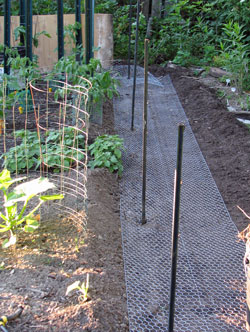 ©Janet Allen
©Janet Allen Laying down the path screen
I looked at a number of different websites (see sidebar) and determined that fencing was my best option. But it had to be done correctly. Since groundhogs can dig under fences I needed to put a barrier on or down into the soil at the base of the fence.
I first raked as much of the mulch and soil as I could off to the side and rolled out two-foot chicken wire laid flat on the ground.
Then I began putting in 4 foot metal fence posts about every five feet. The posts are five or six inches from the edge of the chicken wire.
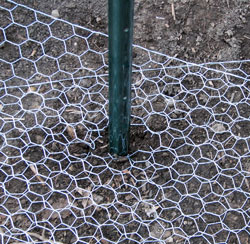 ©Janet Allen
©Janet Allen Closeup of path screen
These posts have a 3-4 inch stabilizer that needs to be pounded into the ground and so I had to cut away some of the wire around where the post was going to go so that the stabilizer didn't "hang up" on the wire as it was pounded in.
I took a two foot piece of rebar and pounded it in where I wanted the post to go to make sure that I wasn't going to encounter shale. If the rebar went down as far as the post needed to go I knew it was okay to pound in the post.
 ©Janet Allen
©Janet Allen Keeping it level
I used a level to make sure each post was as vertical as possible. Once pounded into the soil only 3 feet of each post was above soil level.
 ©Janet Allen
©Janet Allen Attaching fence to path screen
The next step was to add the four foot vertical chicken wire, attached to the posts. Four foot fencing on three foot posts was intentional and probably the key to effectiveness of the fencing. Groundhogs are good climbers, but they don't like wobbly fences. The top foot of the chicken wire is not connected to anything and it tends to flop backwards toward the outside. It is secured to the post below the top of the post with zip ties so that it can't easily be pulled off the post by a ten pound ball of climbing fur. I was careful to make sure that the bottom of the chicken wire was down to the soil level.
Next, and slowest, was to crawl around the fence and connect the vertical chicken wire to the horizontal chicken wire with zip ties every six to nine inches so that the fencing effectively becomes one piece.
The final step was to pull soil and mulch over the chicken wire on the ground so that the wire was covered. This is primarily to protect people walking on the path rather than preventing an avid groundhog from finding the edge of the wire and knowing where to begin digging.
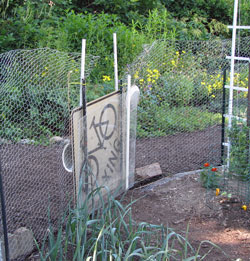 ©Janet Allen
©Janet Allen Double "gate" - plexiglass in back, old metal bike sign in front
There is only one entrance to the three garden beds enclosed in the fencing. I slid a piece of plexiglass on the inside of the fencing using rebar to keep it close to the two fence posts and I slid an old bike route metal sign (gathered some years ago from Onondaga Creek during a clean-up) on the outside, again using rebar to keep it close to the other side of the two fence posts. Presumably groundhogs cannot climb up either of these surfaces.
The only potential weakness I see is that around the opening and at the corners the fencing is taut and could be climbed without wobbling. At the top the animal would then have to jump into the garden. I hung two aluminum pie plates on either side of the entrance because things that move reportly frighten groundhogs.
So far, it seems to be working. The white Russian kale recovered, the parsley regrew, the collards were replaced, and the dinosaur kale was composted and replaced. The gaps in the pole beans and soy beans were reseeded. There has been no further damage to any plants inside the fencing.
 ©Janet Allen
©Janet Allen Evidence of digging
Soon afterward, we saw what appeared to be evidence of digging at the base of the fence at a number of places around the perimeter.
Because of the chicken wire laid on the path (now covered by mulch), the (presumed) groundhog was thwarted. Success!
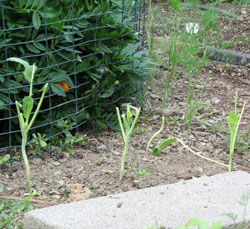 ©Janet Allen
©Janet Allen He's still around
As of a few months after installing the fence, we still hadn't seen evidence of damage. We assumed it was because of our fence solution, but we wondered if perhaps someone in the neighborhood had trapped the groundhog(s), and our success was illusory.
One way to find out: plant some delicacies outside our fenced area and see what happened.
The photo confirms that the groundhog is still around. It's just not able to get inside our fence to eat the rest of the stuff.
The bigger picture
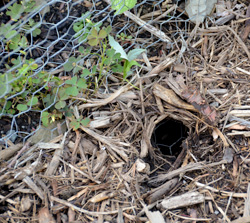 ©Janet Allen
©Janet Allen The underground fencing didn't keep the chipmunk out since he can fit through the holes in the fencing, but that's just a minor annoyance. We enjoy our chipmunks!
Looking at the bigger picture, though, we believe we need to consolidate our human living spaces rather than sprawling out further into natural areas. These creatures and other large animals need places to live, but this can't be in our yards—especially if we're trying to grow our own food!
Alas, groundhogs apparently have always been a problem, even in the Victory Garden era of the 1940s when people raised such a large percentage of our nation's food. People report that they would routinely hunt them, providing an additional source of food, a solution not possible in an urban/suburban environment (and with suburban sensibilities).
In this era, we've designed our habitat garden to provide for creatures smaller than a squirrel—in other words, the things that make the world go 'round—not these larger creatures who need the space we keep stealing from them.

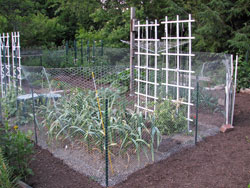 (Enlarge)
(Enlarge)